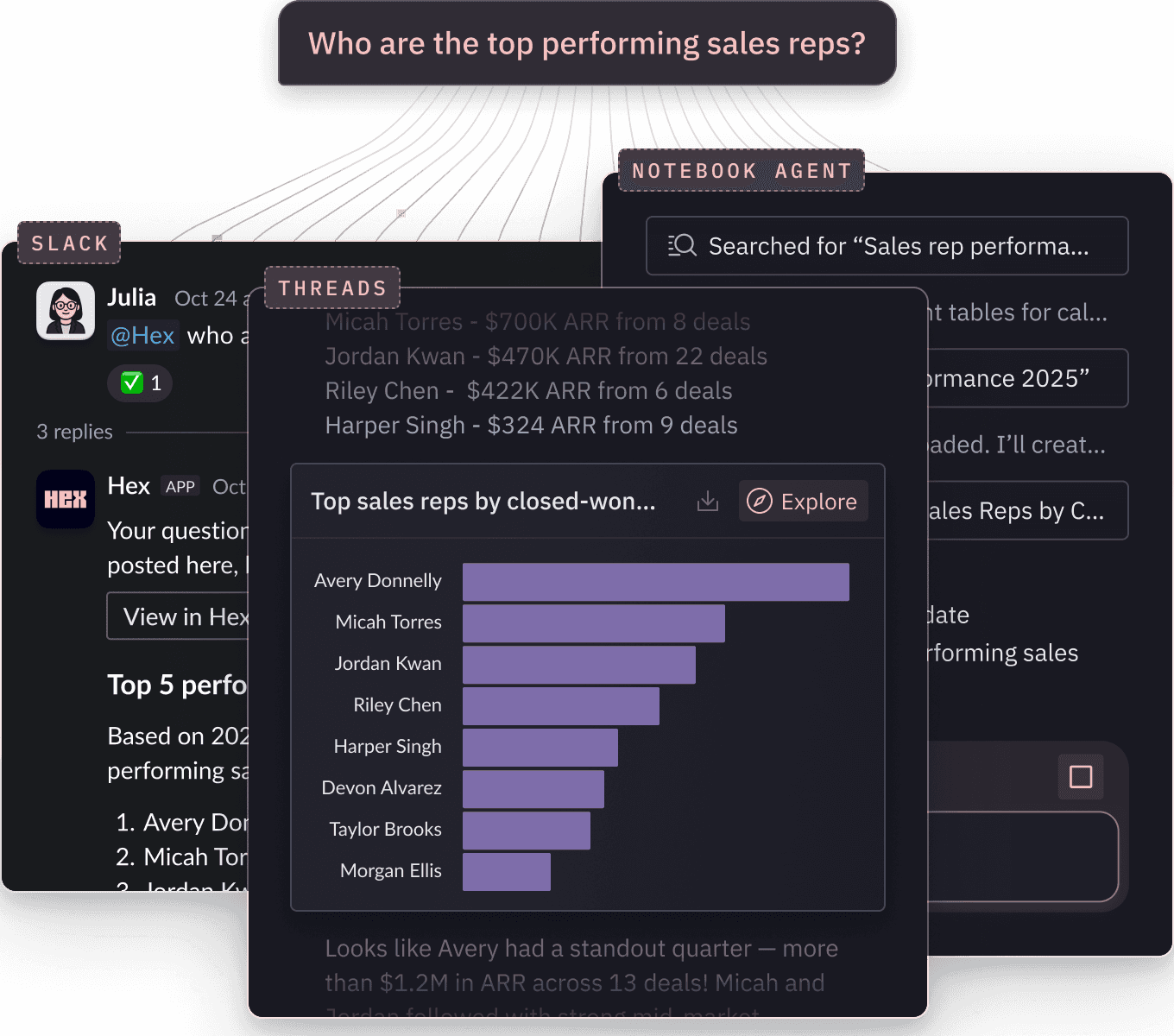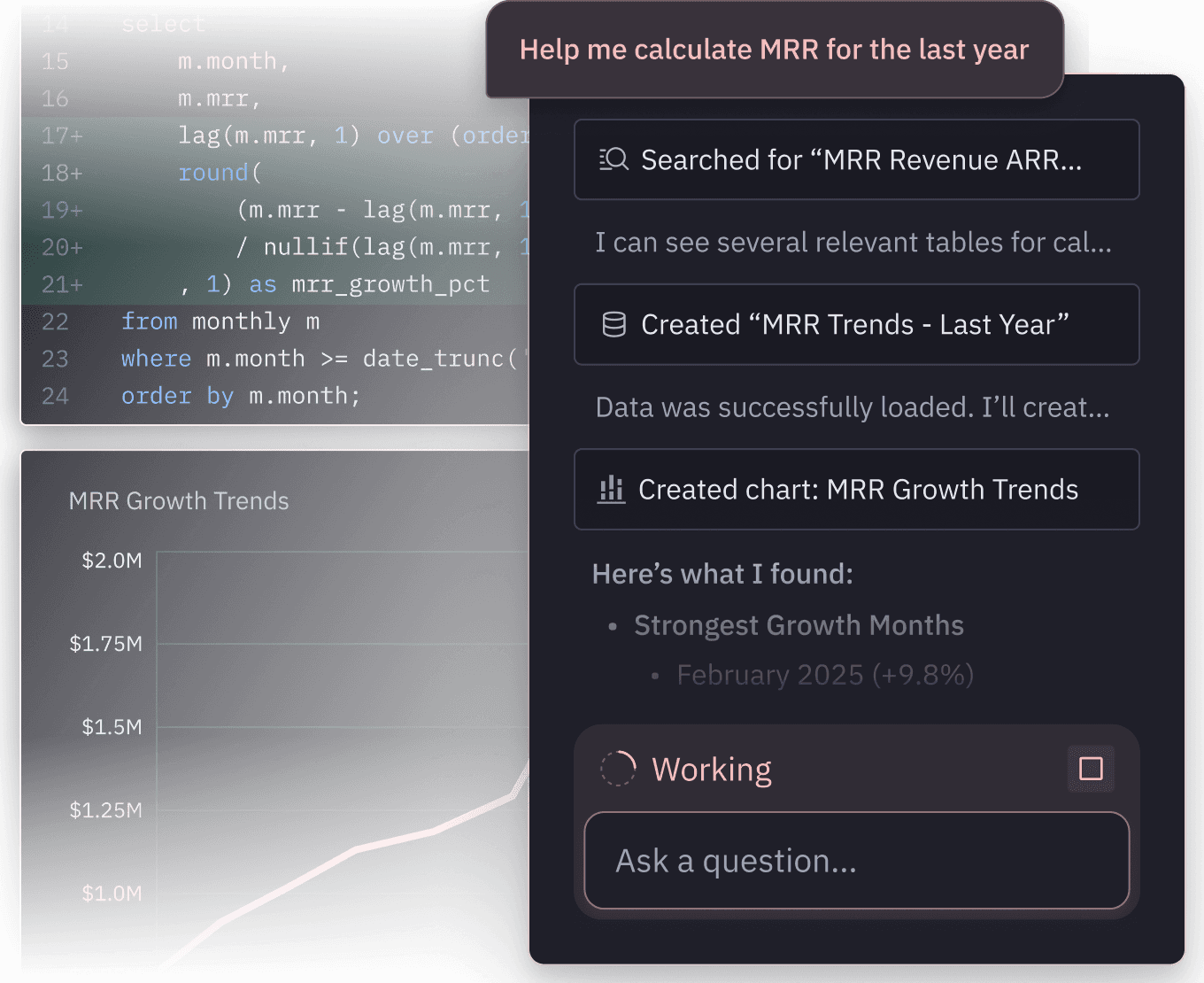Comparing Hex vs. Looker
Thinking of switching from Looker to Hex? Modern data teams make the switch to Hex to power faster and deeper insights with AI.
Trusted by leading data companies
"Our vision for Notion’s data team is that anyone, regardless of technical proficiency, is comfortable using data to answer their own questions – and Hex enables that."
Abhishek Modi, Software Engineer"We like to embed Hex dashboards where teams work."
Ian Macomber, Head of Data and Analytics Engineering"We’re regarded as top performers because the work we are doing is deemed more credible and more widely surfaced than before Hex."
Kate Urquiola, Director, Go-to-Market Analytics"Hex has helped us empower business analysts to explore and dig into data on their own"
Meghana Reddy, Head of Data at Stubhub
Why companies switch from Looker to Hex
Quick questions. Deep analysis. All in plain language.
Looker requires non-technical users to grasp dimensions, measures, and Explores—just to answer simple questions.
With Hex, any question can be explored in plain language. Business users self-serve through Threads, while data teams can explore code-based analysis with the Notebook Agent.

Comparison breakdown
Features
Hex
Looker
AI self-serve
Business users self-serve in plain language
Hex
Threads lets users ask questions in plain language, iterate with follow-ups, and explore answers without knowing SQL or the model.
Looker
Conversational Analytics supports simple, one-shot natural-language questions, but lacks multi-step reasoning.
AI code-based analysis
Generate and refine SQL, Python, and logic with AI
Hex
Notebook Agent assists with writing and refining SQL, Python, and charts; reasons through multi-step logic and debugging.
Looker
No AI support for code generation, debugging, or building analyses.
Seamless collaboration
Continuity of context between business users and data teams
Hex
The seamless handoff from a Thread to a Notebook keeps full context and continuity for inspectability and extension.
Looker
Inspecting underlying logic or extending analysis is limited to Looker’s Explore interface.
No-code exploration
Spreadsheet, drag-and-drop based analysis
Hex
Supports no-code exploration with tables, pivots, and charts for drag-and-drop analysis.
Looker
Supports GUI-based exploration of modeled data through Explores, filters, pivots, and visualizations.
From static dashboards to advanced data apps
With data apps in Hex, you can turn code-based explorations, like forecasting, what-if models, and root-cause analysis, into interactive experiences for end users.
While Looker dashboards are fine for monitoring KPIs, they don’t support complex computation or advanced interactivity.

Comparison breakdown
Features
Hex
Looker
Interactive apps
Dynamic exploration beyond dashboards
Hex
Data apps include inputs and controls (dropdowns, sliders, date pickers, text boxes) enabling truly interactive analysis.
Looker
Dashboards are static with basic filter controls; no input-driven logic or custom interactions.
Advanced analytics
Computation and modeling built in
Hex
Data apps run live Python and SQL, enabling forecasting, what-if scenarios, simulations, and other advanced analyses directly in the app.
Looker
Dashboards display static query results. No embedded computation, modeling, or parameter-driven logic.
Reporting dashboards
Standard KPI and metric tracking
Hex
Build dashboards using no-code charts or full Python visualization libraries.
Looker
Create dashboards with customizable, Explore-powered visualizations based on LookML models.
Flexible governance, unconstrained exploration
LookML provides governance but locks you into a proprietary modeling layer. Every new question triggers edits, reviews, and redeploys.
Hex is flexible: build models in Hex or sync them from dbt, Snowflake, or Cube. When questions go beyond the model, explore freely with agentic notebooks, without switching tools.

Comparison breakdown
Features
Hex
Looker
Ad hoc exploration
Explore unmodeled data freely, all in one place
Hex
Explore frontier questions and new data with SQL, Python, and no-code, all in one environment.
Looker
Exploration is limited to what’s already modeled; you can’t freely query new tables or run code-based analysis.
Interoperable modeling
Use or sync models from multiple sources
Hex
Build models in Hex or sync semantic definitions from dbt, Snowflake, or Cube.
Looker
Logic must be defined in LookML; no support for importing or syncing external semantic layers.
AI-assisted model creation
Jumpstart models using existing project context
Hex
Modeling Agent can reference existing notebooks, queries, and assets to bootstrap new semantic models with natural language.
Looker
Gemini can generate LookML, but cannot reference existing analyses as context for new models.
Unify the full cycle of data work with Hex.
Leave disconnected workflows behind.
Hear from data teams that chose Hex
Learn how the best companies in the world increase team efficiency using Hex.
FAQ
- Explore unmodeled data using SQL, Python, and no-code together in reactive notebooks.
- Ask and iterate in plain language with Threads, without needing to understand modeling concepts in LookML or Explores.
- Turn advanced analysis into an interactive data apps powered by live notebook logic.
- Work in one connected workspace, so exploration, iteration, and sharing stay in sync.
Can't find your answer here? Get in touch.




